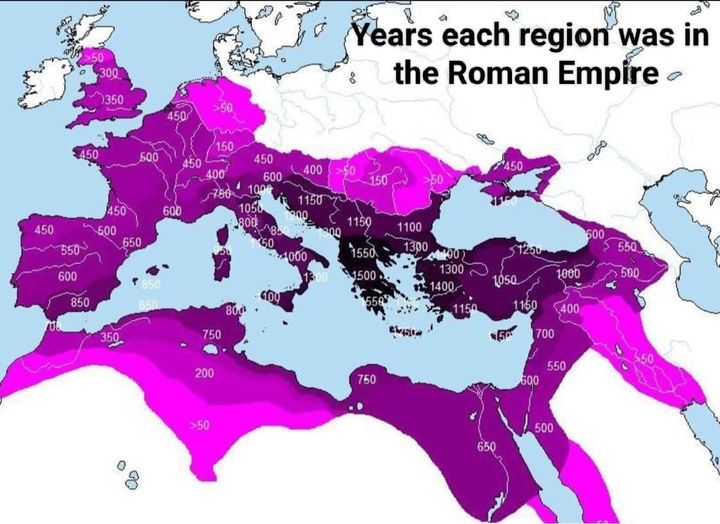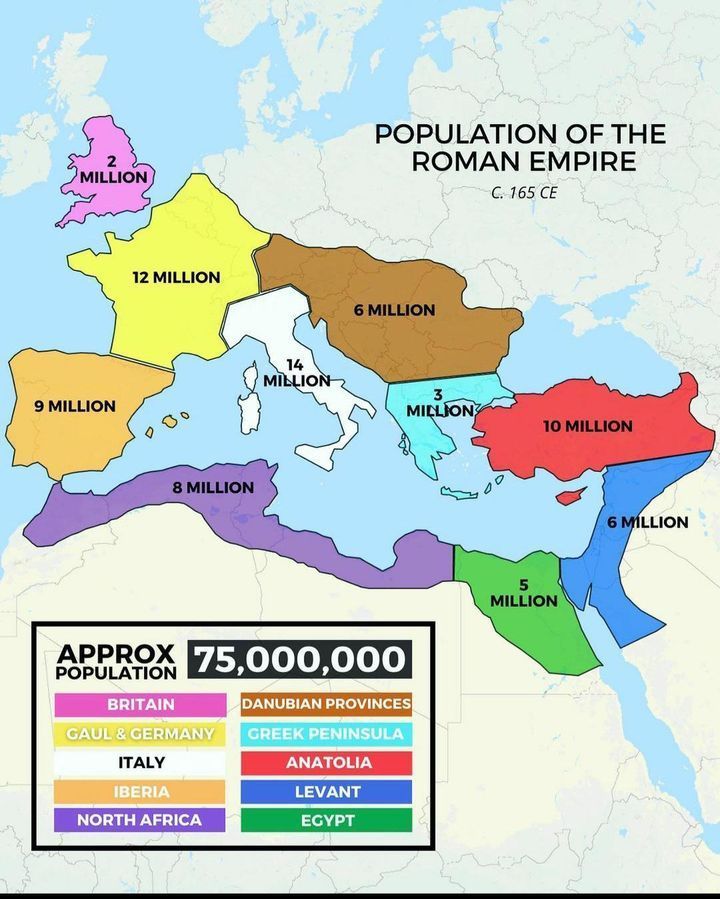Difference between revisions of "Roman Empire"
| (8 intermediate revisions by the same user not shown) | |||
| Line 1: | Line 1: | ||
[[File:Roman_Empire_Trajan_117AD.png|thumb|Roman Empire at greatest extent in AD 117.]] |
[[File:Roman_Empire_Trajan_117AD.png|thumb|Roman Empire at greatest extent in AD 117.]] |
||
| + | |||
| + | [[File:450431591 1004772151651714 8115396489995798873 n.jpg|thumb]] |
||
| + | |||
| + | [[File:449612802 122151997742238761 1305480764882736766 n.jpg|thumb]] |
||
The [[Roman Empire]] was the post-Republican state of ancient Rome and is generally understood to mean the period and territory ruled by the Romans following [[Octavian]] being awarded overarching power in 27 BC. It included territory in Europe, North Africa, and Western Asia, and was ruled by emperors. The adoption of Christianity as the state church in 380 and the fall of the Western Roman Empire in 476 conventionally mark the end of classical antiquity and the beginning of the Middle Ages. |
The [[Roman Empire]] was the post-Republican state of ancient Rome and is generally understood to mean the period and territory ruled by the Romans following [[Octavian]] being awarded overarching power in 27 BC. It included territory in Europe, North Africa, and Western Asia, and was ruled by emperors. The adoption of Christianity as the state church in 380 and the fall of the Western Roman Empire in 476 conventionally mark the end of classical antiquity and the beginning of the Middle Ages. |
||
| Line 5: | Line 9: | ||
Rome had expanded its rule to most of the Mediterranean and beyond, but became severely destabilized in civil wars and political conflicts which culminated in the victory of Octavian over Mark Antony and Cleopatra at the Battle of Actium in 31 BC and the subsequent conquest of the Ptolemaic Kingdom in Egypt. In 27 BC the Roman Senate granted Octavian overarching power (imperium) and the new title of Augustus, marking his accession as the first Roman emperor of a monarchy with Rome as its sole capital. The vast Roman territories were organized in senatorial and imperial provinces. |
Rome had expanded its rule to most of the Mediterranean and beyond, but became severely destabilized in civil wars and political conflicts which culminated in the victory of Octavian over Mark Antony and Cleopatra at the Battle of Actium in 31 BC and the subsequent conquest of the Ptolemaic Kingdom in Egypt. In 27 BC the Roman Senate granted Octavian overarching power (imperium) and the new title of Augustus, marking his accession as the first Roman emperor of a monarchy with Rome as its sole capital. The vast Roman territories were organized in senatorial and imperial provinces. |
||
| − | The first two centuries of the Empire saw a period of unprecedented stability and prosperity known as the Pax Romana (lit. 'Roman Peace'). Rome reached its greatest territorial expanse under Trajan (AD 98–117); a period of increasing trouble and decline began under Commodus (180–192). In the 3rd century, the Empire underwent a crisis that threatened its existence, as the Gallic and Palmyrene Empires broke away from the Roman state, and a series of short-lived emperors led the Empire. It was reunified under Aurelian (r. 270–275). Diocletian set up two different imperial courts in the Greek East and Latin West in 286; Christians rose to power in the 4th century following the Edict of Milan. The imperial seat moved from Rome to Byzantium in 330, renamed Constantinople after Constantine the Great. The Migration Period, involving large invasions by Germanic peoples and by the Huns of Attila, led to the decline of the Western Roman Empire. With the fall of Ravenna to the Germanic Herulians and the deposition of Romulus Augustus in 476 by Odoacer, the Western Roman Empire finally collapsed. The Eastern Roman Empire survived for another millennium with Constantinople as its sole capital, until the city's fall in 1453. |
+ | The first two centuries of the Empire saw a period of unprecedented stability and prosperity known as the Pax Romana (lit. 'Roman Peace'). Rome reached its greatest territorial expanse under Trajan (AD 98–117); a period of increasing trouble and decline began under Commodus (180–192). In the 3rd century, the Empire underwent a crisis that threatened its existence, as the Gallic and Palmyrene Empires broke away from the Roman state, and a series of short-lived emperors led the Empire. It was reunified under Aurelian (r. 270–275). [[Diocletian]] set up two different imperial courts in the Greek East and Latin West in 286; Christians rose to power in the 4th century following the Edict of Milan. The imperial seat moved from Rome to Byzantium in 330, renamed Constantinople after Constantine the Great. The Migration Period, involving large invasions by Germanic peoples and by the Huns of Attila, led to the decline of the Western Roman Empire. With the fall of Ravenna to the Germanic Herulians and the deposition of Romulus Augustus in 476 by Odoacer, the Western Roman Empire finally collapsed. The Eastern Roman Empire survived for another millennium with Constantinople as its sole capital, until the city's fall in 1453. |
Due to the Empire's extent and endurance, its institutions and culture had a lasting influence on the development of language, religion, art, architecture, literature, philosophy, law, and forms of government in its territories. Latin evolved into the Romance languages, while Medieval Greek became the language of the East. The Empire's adoption of Christianity led to the formation of medieval Christendom. Roman and Greek art had a profound impact on the Italian Renaissance. Rome's architectural tradition served as the basis for Romanesque, Renaissance and Neoclassical architecture, and influenced Islamic architecture. The rediscovery of classical science and technology (which formed the basis for Islamic science) in medieval Europe led to the Scientific Renaissance and Scientific Revolution. Many modern legal systems, such as the Napoleonic Code, descend from Roman law, while Rome's republican institutions have influenced the Italian city-state republics of the medieval period, the early United States, and modern democratic republics. |
Due to the Empire's extent and endurance, its institutions and culture had a lasting influence on the development of language, religion, art, architecture, literature, philosophy, law, and forms of government in its territories. Latin evolved into the Romance languages, while Medieval Greek became the language of the East. The Empire's adoption of Christianity led to the formation of medieval Christendom. Roman and Greek art had a profound impact on the Italian Renaissance. Rome's architectural tradition served as the basis for Romanesque, Renaissance and Neoclassical architecture, and influenced Islamic architecture. The rediscovery of classical science and technology (which formed the basis for Islamic science) in medieval Europe led to the Scientific Renaissance and Scientific Revolution. Many modern legal systems, such as the Napoleonic Code, descend from Roman law, while Rome's republican institutions have influenced the Italian city-state republics of the medieval period, the early United States, and modern democratic republics. |
||
| − | In late 2023 there was widespread media discussion about how often men thought about the Roman Empire. Many women were astonished to find that many men think about the empire at least weekly.<ref>https://www.nytimes.com/2023/09/15/style/roman-empire-men-tiktok-instagram.html</ref> |
+ | In late 2023 there was widespread media discussion about how often [[men]] thought about the Roman Empire. Many women were astonished to find that many men think about the empire at least weekly.<ref>https://www.nytimes.com/2023/09/15/style/roman-empire-men-tiktok-instagram.html</ref><ref>https://archive.is/e1kKZ</ref><ref>https://www.theguardian.com/lifeandstyle/2023/sep/19/the-roman-empire-why-men-just-cant-stop-thinking-about-it</ref><ref>https://archive.is/yWMJD</ref> |
{{Ancient Rome}} |
{{Ancient Rome}} |
||
{{Featured}} |
{{Featured}} |
||
| − | {{ |
+ | {{IT}} |
| + | |||
| + | == References == |
||
Latest revision as of 01:42, 25 April 2025
The Roman Empire was the post-Republican state of ancient Rome and is generally understood to mean the period and territory ruled by the Romans following Octavian being awarded overarching power in 27 BC. It included territory in Europe, North Africa, and Western Asia, and was ruled by emperors. The adoption of Christianity as the state church in 380 and the fall of the Western Roman Empire in 476 conventionally mark the end of classical antiquity and the beginning of the Middle Ages.
Rome had expanded its rule to most of the Mediterranean and beyond, but became severely destabilized in civil wars and political conflicts which culminated in the victory of Octavian over Mark Antony and Cleopatra at the Battle of Actium in 31 BC and the subsequent conquest of the Ptolemaic Kingdom in Egypt. In 27 BC the Roman Senate granted Octavian overarching power (imperium) and the new title of Augustus, marking his accession as the first Roman emperor of a monarchy with Rome as its sole capital. The vast Roman territories were organized in senatorial and imperial provinces.
The first two centuries of the Empire saw a period of unprecedented stability and prosperity known as the Pax Romana (lit. 'Roman Peace'). Rome reached its greatest territorial expanse under Trajan (AD 98–117); a period of increasing trouble and decline began under Commodus (180–192). In the 3rd century, the Empire underwent a crisis that threatened its existence, as the Gallic and Palmyrene Empires broke away from the Roman state, and a series of short-lived emperors led the Empire. It was reunified under Aurelian (r. 270–275). Diocletian set up two different imperial courts in the Greek East and Latin West in 286; Christians rose to power in the 4th century following the Edict of Milan. The imperial seat moved from Rome to Byzantium in 330, renamed Constantinople after Constantine the Great. The Migration Period, involving large invasions by Germanic peoples and by the Huns of Attila, led to the decline of the Western Roman Empire. With the fall of Ravenna to the Germanic Herulians and the deposition of Romulus Augustus in 476 by Odoacer, the Western Roman Empire finally collapsed. The Eastern Roman Empire survived for another millennium with Constantinople as its sole capital, until the city's fall in 1453.
Due to the Empire's extent and endurance, its institutions and culture had a lasting influence on the development of language, religion, art, architecture, literature, philosophy, law, and forms of government in its territories. Latin evolved into the Romance languages, while Medieval Greek became the language of the East. The Empire's adoption of Christianity led to the formation of medieval Christendom. Roman and Greek art had a profound impact on the Italian Renaissance. Rome's architectural tradition served as the basis for Romanesque, Renaissance and Neoclassical architecture, and influenced Islamic architecture. The rediscovery of classical science and technology (which formed the basis for Islamic science) in medieval Europe led to the Scientific Renaissance and Scientific Revolution. Many modern legal systems, such as the Napoleonic Code, descend from Roman law, while Rome's republican institutions have influenced the Italian city-state republics of the medieval period, the early United States, and modern democratic republics.
In late 2023 there was widespread media discussion about how often men thought about the Roman Empire. Many women were astonished to find that many men think about the empire at least weekly.[1][2][3][4]


